
Argentinosaurus is a genus of giant sauropod dinosaur that lived during the Late Cretaceous period in what is now Argentina. Although it is only known from fragmentary remains, Argentinosaurus is one of the largest known land animals of all time, perhaps the largest, measuring 30–35 m (98–115 ft) long and weighing 65–80 t. It was a member of Titanosauria, the dominant group of sauropods during the Cretaceous. It is widely regarded by many paleontologists as the biggest dinosaur ever, and perhaps lengthwise the longest animal ever, though both claims have no concrete evidence yet.

Buitreraptor is a genus of dromaeosaurid dinosaurs that lived during the Late Cretaceous of Argentina at the Candeleros Formation. Buitreraptor was described in 2005 and the type species is Buitreraptor gonzalezorum. It was rooster-sized and had a very elongated head with many small teeth.
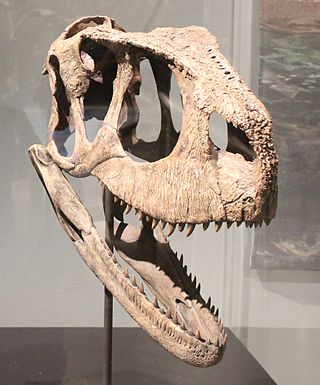
Rugops is a monospecific genus of basal abelisaurid theropod dinosaur from Niger that lived during the Late Cretaceous period in what is now the Echkar Formation. The type and only species, Rugops primus, is known only from a partial skull. It was named and described in 2004 by Paul Sereno, Jeffery Wilson and Jack Conrad. Rugops has an estimated length of 4.4–5.3 metres (14–17 ft) and weight of 410 kilograms (900 lb). The top of its skull bears several pits which correlates with overlaying scale and the front of the snout would have had an armour-like dermis.

Bonitasaura is a genus of titanosaurian dinosaur hailing from uppermost layers of the Late Cretaceous (Santonian) Bajo de la Carpa Formation, Neuquén Group of the eastern Neuquén Basin, located in Río Negro Province, Northwestern Patagonia, Argentina. The remains, consisting of a partial sub-adult skeleton jumbled in a small area of fluvial sandstone, including a lower jaw with teeth, a partial vertebrae series, and limb bones, were described by Sebastian Apesteguía in 2004.

Mapusaurus was a giant carcharodontosaurid carnosaurian dinosaur from Argentina during the Turonian age of the Late Cretaceous.
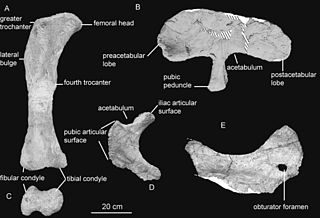
Rocasaurus is a genus of titanosaurian sauropod that lived in South America. Rocasaurus was discovered in Argentina in 2000, within the Allen Formation which is dated to be middle Campanian to early Maastrichtian in age. This genus grew up to 8 metres (26 ft) long, making it one of the smaller sauropods. It seems to be closely related to saltasaurid dinosaurs, like Saltasaurus and Neuquensaurus.
The Huincul Formation is a geologic formation of Late Cretaceous age of the Neuquén Basin that outcrops in the Mendoza, Río Negro and Neuquén Provinces of northern Patagonia, Argentina. It is the second formation in the Río Limay Subgroup, the oldest subgroup within the Neuquén Group. Formerly that subgroup was treated as a formation, and the Huincul Formation was known as the Huincul Member.

Brachyrostra is a clade within the theropod dinosaur family Abelisauridae. It includes the famous genera Carnotaurus, Abelisaurus, Aucasaurus as well as their close relatives from the Cretaceous Period of Argentina and Brazil plus Caletodraco from France. The group was first proposed in an analysis conducted by Juan Canale and colleagues in 2008. They found that all South American abelisaurids described up to that point grouped together as a sub-clade of Abelisauridae, which they named based on the relatively unusual shape of their skulls. They defined the clade Brachyrostra as "all the abelisaurids more closely related to Carnotaurus sastrei than to Majungasaurus crenatissimus."
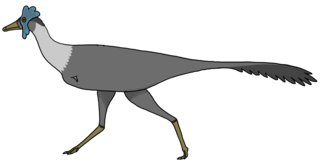
Bonapartenykus is a monospecific genus of alvarezsauroid dinosaur from Argentina that lived during the Late Cretaceous (Campanian-Maastrichtian) in what is now the upper Allen Formation of the Río Negro Province. The type and only species, Bonapartenykus ultimus, is known from a nearly articulated but partial skeleton that was found in close association to two incomplete eggs and several clusters of eggshells belonging to the oogenus Arriagadoolithus. Bonapartenykus was named in 2012 by Federico L. Agnolin, Jaime E. Powell, Fernando E. Novas and Martin Kundrát. Bonapartenykus has an estimated length of 2.5 m (8.2 ft) and weight of 72 kg (159 lb), making it the largest member of the clade Alvarezsauroidea.

Taurovenator is a large carcharodontosaurid theropod from the late Cretaceous Huincul Formation of Argentina that lived during the Cenomanian age of the Late Cretaceous. It is monotypic, containing only one species, T. violantei.
Aoniraptor is a genus of possibly megaraptoran or bahariasaurid theropod dinosaur from the Late Cretaceous of Argentina.
Tralkasaurus is a genus of abelisaurid dinosaur from the Huincul Formation from Río Negro Province in Argentina. The type and only species is Tralkasaurus cuyi, named in 2020 by Mauricio Cerroni and colleagues based on an incomplete skeleton. A medium-sized abelisaurid, Tralkasaurus exhibits a conflicting blend of characteristics found among the early-diverging abelisauroids with others that characterize the highly specialized clade Brachyrostra, and thus its position within the clade is poorly-resolved.
Kaikaifilusaurus is an extinct genus of rhynchocephalians in the family Sphenodontidae from the Late Cretaceous of South America. Fossils of the genus were found in Cenomanian sediments of the Candeleros Formation and Turonian layers of the Huincul Formation, both of the Neuquén Basin and the Albian strata of the Cerro Barcino Formation in the Cañadón Asfalto Basin, all in Patagonia, Argentina. The genus contains two species, K. minimus and the type species K. calvoi.

Overoraptor is an extinct genus of paravian theropod of uncertain affinities from the Late Cretaceous Huincul Formation of Argentinian Patagonia. The genus contains a single species, O. chimentoi, known from several bones of the hands, feet, and hips alongside some vertebrae.

Meraxes is a genus of large carcharodontosaurid theropod dinosaur from the Late Cretaceous Huincul Formation of Patagonia, Argentina. The genus contains a single species, Meraxes gigas.
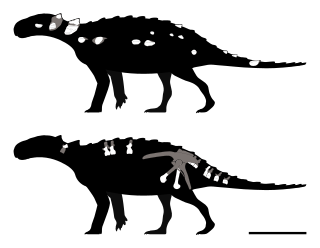
Patagopelta is an extinct genus of ankylosaurian dinosaur from the Late Cretaceous Allen Formation of Argentina. The genus contains a single species, P. cristata, known from a partial skeleton. While originally described as a nodosaurine, later discoveries provided support for parankylosaurian affinities for the taxon. Patagopelta is a very small ankylosaur, comparable in size to the dwarf nodosaurid Struthiosaurus, about 2 m (6.6 ft) long.
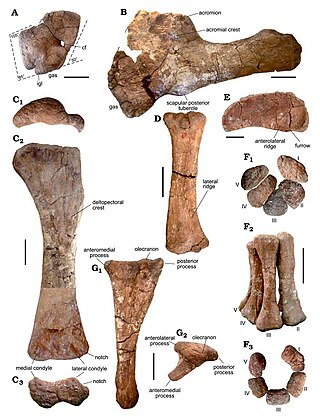
Bustingorrytitan is a genus of lithostrotian titanosaur from the Late Cretaceous (Cenomanian) Huincul Formation of Argentina. The type species is Bustingorrytitan shiva.
Sidersaura is an extinct genus of rebbachisaurid sauropod dinosaur from the Late Cretaceous Huincul Formation of Argentina. The genus contains a single species, S. marae, known from the remains of four individuals. Sidersaura represents one of the largest known rebbachisaurids.

Chakisaurus is an extinct genus of elasmarian ornithopod dinosaur from the Late Cretaceous Huincul Formation of Argentina. The genus contains a single species, C. nekul, known from multiple partial skeletons belonging to individuals of different ages. Chakisaurus represents the first ornithischian species to be named from the Huincul Formation.





























